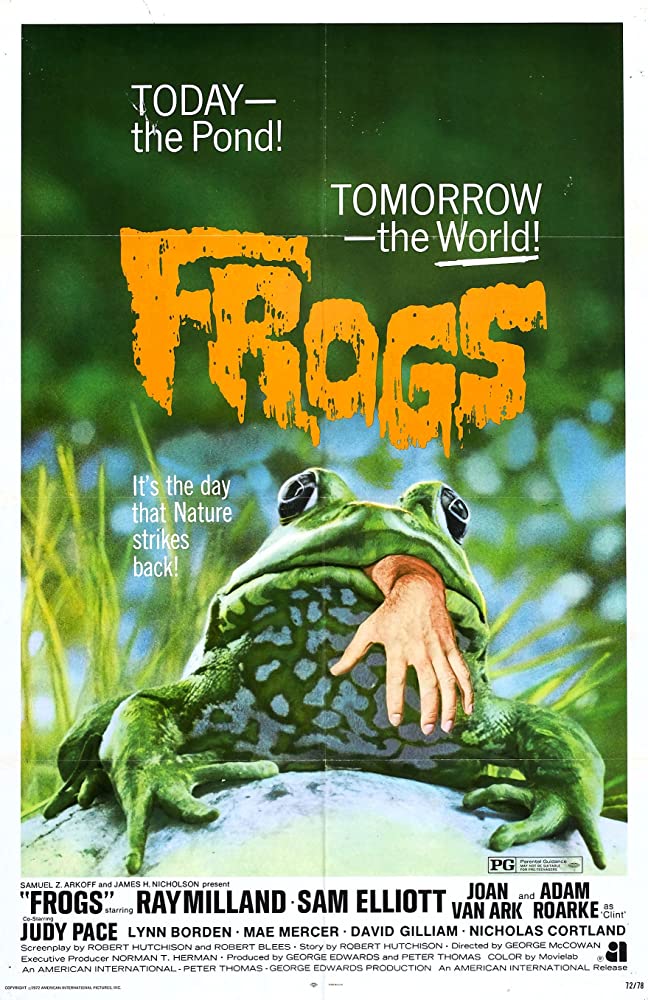Previous FilmFour Sided Triangle
Next FilmFrom Hell It Came
Frogs 1972
 | A group of helpless victims celebrate a birthday on an island estate crawling with killer amphibians, birds, insects, and reptiles. |
The Director: George McCowanThe Writers: Robert Hutchison, Robert Blees, Robert HutchisonMusic by: Les Baxter Certificate : X
Film Trivia
Many of the 500 Florida frogs and 100 giant South American toads purchased for use in the film escaped during production.
In a review for "Andy Warhol's Interview", writer Fran Lebowitz called this movie "the best bad movie I have ever seen in my life."
Due to the film's low budget, no live birds were used for the bird attack scene. Footage of flying birds was superimposed over footage of the running cast.
Scenes of Sam Elliot shirtless helped him land the starring role in Lifeguard (1976).
The Florida Holiday Inn used by the crew would not allow the poisonous snakes, spiders, or black scorpions used in the film to be brought into the hotel.
Stephen King has mentioned this movie as the reason he decided on a topiary instead of a hedge maze in The Shining (1980). Stanley Kubrick could not get the topiary to work to his satisfaction, so he went with the hedge maze instead.
This was the first of many "eco-horror" films of the 1970s, inspired by the surprise box-office success of Willard (1971).
Because the film's poster art depicts a human hand hanging out of a huge frog's mouth, viewers often assume the film is about giant man-eating frogs, rather than swamp wildlife on the rampage.
A bedroom scene, in which Bella asks Kenneth to take her home, was scripted and shot but cut from the movie. Photographs of the scene, featuring a bare-chested Nicholas Cortland smoking a joint, were released with the film's press material.
One publicity shot shows Lynn Borden holding a frog on a leash.
Ray Milland wore a toupee throughout filming. He sweated so much that it fell off of his head several times.
The movie made the cover of Famous Monsters of Filmland magazine. The cover depicted a scowling frog with a human hand sticking out of its mouth, different from the film's poster.
The mansion used for the Crockett family home is the Wesley House, built in 1897. It's part of Eden Gardens State Park, in Santa Rosa Beach, Florida.
The large black and white lizards that attack Kenneth in the greenhouse are Tegus, native to Argentina. Several geckos and iguanas were also used for the scene.
The film was released as double feature with Godzilla vs the Smog Monster (1971).
Iris was originally supposed to be lured into a quicksand pit by butterflies, and drown. The scene was shot, but it was deemed too silly for the final film. The scene was re-shot to have Iris killed by a rattlesnake instead. Clips of the original death scene appear in the film's trailer.
The ending implies that the island incident was not isolated, and that an apocalyptic animal revolution had begun on the mainland as well.
The movie implies that most animals have turned on humans. Crockett's family dog stays loyal until the end, which may imply that dogs are not part of the animal revolution. This would support the popular saying that "dogs are Man's best friend".
Ray Milland reportedly hated the production so much that he left three days early. Much of Jason Crockett's death scene had to be shot with a double.
At first, the animals seem to attack the Crocketts out of revenge. The grandmother is a butterfly collector, the grandfather has a trophy room, the others want the frogs poisoned because of their constant croaking. The animals even seem to spare Pickett Smith in the beginning. The animals eventually attack him, though that might be because he decided to help the Crocketts. If the "animal apocalypse" theory is correct, then Smith's actions don't influence their deadly behavior after all.